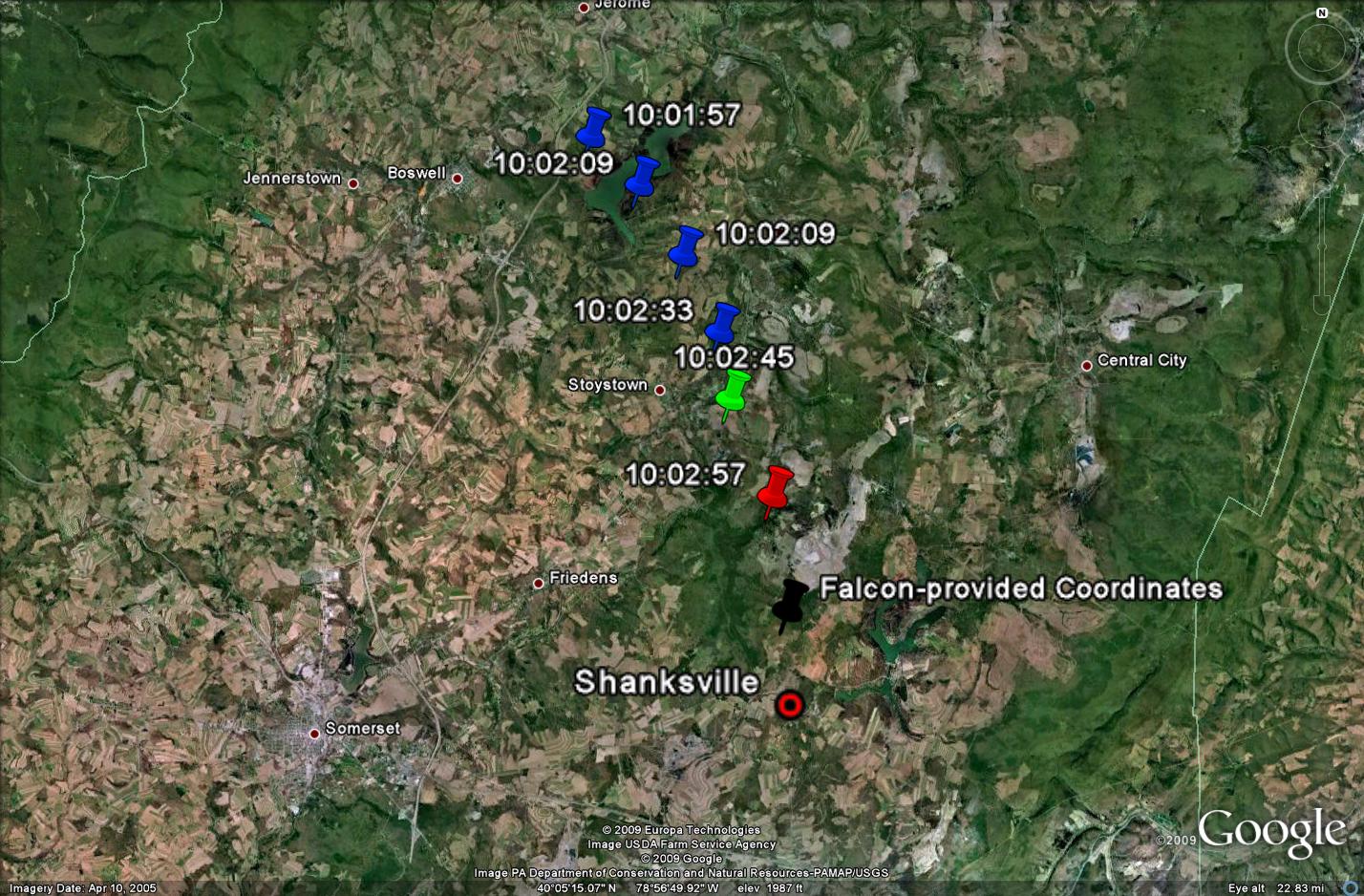Addendum, December 1, 2009.
Here is a Google Earth plot of the final radar returns from UA 93 as received at The Plains radar site and provided by 84th RADES.

The blue pins depict primary returns. The green pin depicts the first recording of the transponder back on. Green represents a reinforced return, radar and beacon (transponder). The red pin depicts the second and final transponder return, beacon only.
This is the air traffic control story of UA 93, told in the primary source voices of the day, and we begin with part 2, the Herndon Command Center story. The next two articles will tell the same story from the Cleveland Center (ZOB) perspective, Part 1, Then, in Part 3, we will the FAA’s Washington Operations Center story, as told to them by air traffic control. There will be at least one additional article to tell the story after it leaves the domain of air traffic control.
First notice to Herndon
The story begins at 09:49 when Margaret at the Herndon Severe Weather position convenes a conference with Washington Center, ZDC, at the request of Cleveland and Chicago. The purpose is to address the issue of the Attorney General’s return to Washington. Cleveland breaks in to tell Chicago about Delta 1989. That conversation is at this link. ZDC ZOB Herndon Chicago Teleconference
The conversation immediately continues and by 9:50 Cleveland Center has also put Washington Center on alert but about a different airplance, UA 93. That continued conversation is at this link. ZOB alerts ZDC about UA 93
After a short pause ZOB estimates a UA 93 arrival in 25 minutes to Dulles (approximately 9:16). Concurrently, ZOB updates both Chicago and ZDC as to the status of both D 1989 and UA 93. That continuation is at this link. ZOB updates D 1989 and UA 93
Some researchers have speculated that FAA was treating one of the two aircraft but not the other as a hijack; that the two were somehow confused by air traffic control. It is clear from the primary source information that the two situations were distinct and clearly separated by Cleveland Center in its reporting to adjacent centers and to Herndon. There was no confusion within the system as to which was which. The status of D 1989 was never conflated with UA 93 by FAA.
Conversation continues at 09:53
The situation continues as ZOB updates all participants on the status of both airplanes. Margaret informs ZOB that Herndon knew about UA 93 but not about D 1989 and she will pass the word. That update can be heard at this link. ZOB Undates Participants at 0953
D 1989 apparently resolved
In a conversation at 9:56 Herndon determines that D 1989 is not a ‘trip,’ that he is fine and that he is going to Cleveland. In this conversation we learn that the concern about D 1989 originated with Boston Center, ZBW. That conversation can be heard at this link. ZOB D 1989 Going to Clevelend
Real time updates on UA 93
By 9:58 ZOB enters a new flight plan for UA 93 to assist ZDC. ZDC acknowledges and sees the airplane at their TMU desk. ZOB is trying as best it can to associate tracking information with the data blocks. They did not have an altitude.
The implication is that ZDC can see the plane on radar as long as it is flying and can track the flight plan on a TSD display. The exchange of information between the TMU at ZOB and the TMUat ZDC can be heard at this link. ZOB UA 93 new flight plan and alert to ZDC. I should note here that when I observed the TSD playback of 9-11 at Herndon Center the icon for UA 93 visably jumped on the screen to its new location as determined by ZOB.
Shortly thereafter, in the 9:59 time frame, ZOB did obtain altitude information on UA 93 from a VFR aircraft. That information can be heard at this link. ZOB reports altitude on UA 93 Whenever Ricky Bell at Severe Weather keeps the microphone open you can hear voices in the background. We will cover that in Part 3 when we talk about Herndon continuously updating FAA Headquarters.
Next, ZOB provides altitude and heading information in real time to Herndon. You can, again, hear voices in the background and you hear Ricky Bell repeating information as he hears it so that others at Herndon are aware. This minute long conversation segment begins approximately 10:00 and can be heard at this link. ZOB provides location and heading for UA 93
From 10:01 to 10:02 the real time updates report erratic flying. That near one minute conversation segment can be heard at this link. ZOB reports erratic flying
UA 93 transponder back on
The UA 93 transponder did come back on, briefly for two sweeps just before 10:03. 84th RADES radar lost coverage on the plane soon after 9:47, but reacquired the aircraft near the end of its flight. Radar data from The Plains radar shows the transponder back on for just two radar returns. Based on those two returns the aircraft dropped at a significant rate. It was in extremis. The last recorded RADES radar return is at 10:02:57 at 6100 feet altitude. Location was 40 040 04N 78 55 02W.
ZOB describes the transponder event to Herndon as heard on this link. ZOB Reports Transponder Back On. The ZOB report is time consistent and altitude consistent with RADES radar. ZOB reports an altitude of 8200 feet when the transponder came back on. The RADES radar files show an altitude of 7800 feet at that time.
Here is a circa Summer 93 graphic I prepared concerning UA 93. My complete set of UA 93 powerpoint slides has been uploaded to the History Commons Scribd site; I can’t find the link for now, and is available at this link.
UA 93 lost by ZOB
Just before 10:03 ZOB reports losing UA 93 on radar except for one primary return. ZOB defers to ZDC as can be heard at this link. ZOB losing UA 93 on radar
A few moments later Herndon reconnects with ZOB to ask about both UA 93 and D 1989. Herndon learns that ZOB has lost UA 93; it was last headed toward Washington. Herndon also learns at the same time that D 1989 is not a hijack. That exchange can be heard at this link. ZOB advises UA 93 lost D1989 not a hijack
And, to finish off part 2 of this trilogy, at 10:10 ZOB and Herndon have a concluding converstion that reaffirms that ZOB has lost UA 93 on radar and that D 1989 is not a hijack. This conversation segment provides additional insight in how Herndon was operating and what it knew. ZOB Herndon Discusses Both Planes
Observations in real time
First, at no time at the desk level, do air traffic control personnel speak to or even mention contacting the military. That is to be expected, their job was to track and report.
Second, at no time did Herndon or ZOB conflate information concerning UA 93 and D 1989. Both planes were monitored distinctly and separately and reported that way. FAA up to the Herndon level had situation awareness in real time. Researchers who argue differently are simply wrong.
Third, separately, ZOB is learning of the fate of UA 93 and we will discuss that in Part 1 of this trilogy. For now, the embedded graphic provides useful data points. Gofer 06 soon after turning north at ZOB direction reported shortly after 10:04 that the pilot saw smoke in the direction of UA 93. The private jet, N20VF? on the graphic, was vectored by ZOB to the crash site. The Falcon circled once and provided GPS coordinates around 10:14.
Finally, at the national level. Norman Mineta is arriving at the PEOC during the final moments of UA 93. Subsequently he will receive information from Monte Belger about that aircraft, most likely as seen on a TSD display. That track, terminating at Reagan National at 10:28 is a ghost and has been since shortly after 10:03.
That begs a question. Given that Herndon had near real time information and was immediately passing that information to FAA Headquarters, how was that being passed, if at all, to the national level? We will grapple with that in Part 3. For now I would simply point out that the SVTS link was activated at 9:25 and Richard Clarke convened the conference soon after 9:40. He wrote in Against All Enemies, “Okay, I began. Let’s start with the facts. FAA, FAA, go.” Jane Garvey was at the FAA end.
What do we make of that?
I am separately publishing articles on the linear processes the government attempted to use that day. So far I have spoken to NOIWON. Once I get an Air Threat Conference article out I will then turn to SVTS. Suffice it to say for now that, as I’ve elsewhere attributed to an NMCC staff officer, the SVTS process was counter-productive.
So, I will speak to SVTS, probably before I write Part 3 of this air traffic control trilogy concerning UA 93.
At some point, of course, we will ultimately need to address the Mineta story.
